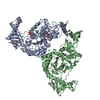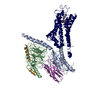登録情報 データベース : EMDB / ID : EMD-21972タイトル Human secretin receptor Gs complex post-processed consensus refinement 複合体 : Gs coupled secretin complex with secretin peptide複合体 : Guanine nucleotide-binding protein G(s) subunit alpha isoforms short, Guanine nucleotide-binding protein G(I)/G(S)/G(T) subunit beta-1, Guanine nucleotide-binding protein G(I)/G(S)/G(O) subunit gamma-2, Secretin receptorタンパク質・ペプチド : Secretin receptorタンパク質・ペプチド : Guanine nucleotide-binding protein G(s) subunit alpha isoforms shortタンパク質・ペプチド : Guanine nucleotide-binding protein G(I)/G(S)/G(T) subunit beta-1タンパク質・ペプチド : Guanine nucleotide-binding protein G(I)/G(S)/G(O) subunit gamma-2複合体 : Nanobody35複合体 : Secretin / / / 機能・相同性 分子機能 ドメイン・相同性 構成要素
/ / / / / / / / / / / / / / / / / / / / / / / / / / / / / / / / / / / / / / / / / / / / / / / / / / / / / / / / / / / / / / / / / / / / / / / / / / / / / / / / / / / / / / / / / / / / / / / / / / / / / / / / / / / / / / / / / / / / / / / / / / / / / / / / / / / / / / / / / / / / / / / / / / / / / / / / / / / / / / / / / / / / / / 生物種 Homo sapiens (ヒト) / Lama glama (ラマ)手法 / / 解像度 : 2.3 Å Piper SJ / Belousoff MJ 資金援助 Organization Grant number 国 National Institutes of Health/National Institute of Diabetes and Digestive and Kidney Disease (NIH/NIDDK) GM-132095 National Health and Medical Research Council (NHMRC, Australia) 1120919 National Health and Medical Research Council (NHMRC, Australia) 1150083 Royal Society BB/M006883/1
ジャーナル : Nat Commun / 年 : 2020タイトル : Structure and dynamics of the active Gs-coupled human secretin receptor.著者: Maoqing Dong / Giuseppe Deganutti / Sarah J Piper / Yi-Lynn Liang / Maryam Khoshouei / Matthew J Belousoff / Kaleeckal G Harikumar / Christopher A Reynolds / Alisa Glukhova / Sebastian G B ... 著者 : Maoqing Dong / Giuseppe Deganutti / Sarah J Piper / Yi-Lynn Liang / Maryam Khoshouei / Matthew J Belousoff / Kaleeckal G Harikumar / Christopher A Reynolds / Alisa Glukhova / Sebastian G B Furness / Arthur Christopoulos / Radostin Danev / Denise Wootten / Patrick M Sexton / Laurence J Miller / 要旨 : The class B secretin GPCR (SecR) has broad physiological effects, with target potential for treatment of metabolic and cardiovascular disease. Molecular understanding of SecR binding and activation ... The class B secretin GPCR (SecR) has broad physiological effects, with target potential for treatment of metabolic and cardiovascular disease. Molecular understanding of SecR binding and activation is important for its therapeutic exploitation. We combined cryo-electron microscopy, molecular dynamics, and biochemical cross-linking to determine a 2.3 Å structure, and interrogate dynamics, of secretin bound to the SecR:Gs complex. SecR exhibited a unique organization of its extracellular domain (ECD) relative to its 7-transmembrane (TM) core, forming more extended interactions than other family members. Numerous polar interactions formed between secretin and the receptor extracellular loops (ECLs) and TM helices. Cysteine-cross-linking, cryo-electron microscopy multivariate analysis and molecular dynamics simulations revealed that interactions between peptide and receptor were dynamic, and suggested a model for initial peptide engagement where early interactions between the far N-terminus of the peptide and SecR ECL2 likely occur following initial binding of the peptide C-terminus to the ECD. 履歴 登録 2020年5月13日 - ヘッダ(付随情報) 公開 2020年8月12日 - マップ公開 2020年8月12日 - 更新 2024年10月23日 - 現状 2024年10月23日 処理サイト : RCSB / 状態 : 公開
すべて表示 表示を減らす
 データを開く
データを開く 基本情報
基本情報 マップデータ
マップデータ 試料
試料 キーワード
キーワード 機能・相同性情報
機能・相同性情報 Homo sapiens (ヒト) /
Homo sapiens (ヒト) / 
 データ登録者
データ登録者 米国,
米国,  オーストラリア,
オーストラリア,  英国, 4件
英国, 4件  引用
引用 ジャーナル: Nat Commun / 年: 2020
ジャーナル: Nat Commun / 年: 2020





 構造の表示
構造の表示 ムービービューア
ムービービューア SurfView
SurfView Molmil
Molmil Jmol/JSmol
Jmol/JSmol ダウンロードとリンク
ダウンロードとリンク emd_21972.map.gz
emd_21972.map.gz EMDBマップデータ形式
EMDBマップデータ形式 emd-21972-v30.xml
emd-21972-v30.xml emd-21972.xml
emd-21972.xml EMDBヘッダ
EMDBヘッダ emd_21972_fsc.xml
emd_21972_fsc.xml FSCデータファイル
FSCデータファイル emd_21972.png
emd_21972.png emd_21972_msk_1.map
emd_21972_msk_1.map マスクマップ
マスクマップ emd-21972.cif.gz
emd-21972.cif.gz emd_21972_additional_1.map.gz
emd_21972_additional_1.map.gz emd_21972_additional_2.map.gz
emd_21972_additional_2.map.gz emd_21972_additional_3.map.gz
emd_21972_additional_3.map.gz emd_21972_half_map_1.map.gz
emd_21972_half_map_1.map.gz emd_21972_half_map_2.map.gz
emd_21972_half_map_2.map.gz http://ftp.pdbj.org/pub/emdb/structures/EMD-21972
http://ftp.pdbj.org/pub/emdb/structures/EMD-21972 ftp://ftp.pdbj.org/pub/emdb/structures/EMD-21972
ftp://ftp.pdbj.org/pub/emdb/structures/EMD-21972 emd_21972_validation.pdf.gz
emd_21972_validation.pdf.gz EMDB検証レポート
EMDB検証レポート emd_21972_full_validation.pdf.gz
emd_21972_full_validation.pdf.gz emd_21972_validation.xml.gz
emd_21972_validation.xml.gz emd_21972_validation.cif.gz
emd_21972_validation.cif.gz https://ftp.pdbj.org/pub/emdb/validation_reports/EMD-21972
https://ftp.pdbj.org/pub/emdb/validation_reports/EMD-21972 ftp://ftp.pdbj.org/pub/emdb/validation_reports/EMD-21972
ftp://ftp.pdbj.org/pub/emdb/validation_reports/EMD-21972 リンク
リンク EMDB (EBI/PDBe) /
EMDB (EBI/PDBe) /  EMDataResource
EMDataResource マップ
マップ ダウンロード / ファイル: emd_21972.map.gz / 形式: CCP4 / 大きさ: 91.1 MB / タイプ: IMAGE STORED AS FLOATING POINT NUMBER (4 BYTES)
ダウンロード / ファイル: emd_21972.map.gz / 形式: CCP4 / 大きさ: 91.1 MB / タイプ: IMAGE STORED AS FLOATING POINT NUMBER (4 BYTES) emd_21972_msk_1.map
emd_21972_msk_1.map 試料の構成要素
試料の構成要素 解析
解析 試料調製
試料調製 電子顕微鏡法
電子顕微鏡法 FIELD EMISSION GUN
FIELD EMISSION GUN
 ムービー
ムービー コントローラー
コントローラー




































 Z (Sec.)
Z (Sec.) Y (Row.)
Y (Row.) X (Col.)
X (Col.)





































































 Trichoplusia ni (イラクサキンウワバ)
Trichoplusia ni (イラクサキンウワバ)

